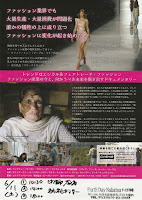On 11 June I went to see a movie to Nakatsu city. The film meeting was held by the group “Earth Day Nakatsu”.
I saw “The True Cost”, which has revealed what going on behind the fashion industry.
In U.S. the clothes people ware used to be produced by domestic factories but now 95% of clothes are produced in developing countries.
The fast fashion companies seek the cheapest wage country to produce their clothes.That’s the reason why the garment factories are concentrated in Bangladesh. The garment workers are making clothes under cruel condition. Once the factory building had collapsed, hundreds of people were killed or injured. In Cambodia, some garment workers had established a labor union and had got to the negotiating table with the owners, but they didn’t reach agreement, then, unbelievably, they locked the door and beaten the workers ―all female― with their fists, with the chairs, with the tables.
The problem is not only the fact that the garment workers’ human rights are neglected, but also the extreme consumption hurts environment.
So much waste of clothes are piled up and exhaust toxic gas. If you donate your clothes, it cause another problem, the majority of those clothes are exported to developing countries. One of the examples, in Haiti the charity clothes led the domestic fashion industry destroy. The employees of garment factory are not needed any more.
This movie also has researched agriculture. Nowadays agribusiness is based on GMO seeds and so much chemical fertilizer and pesticide. The people who deals with agriculture are ruined their health and their children’s health.
It looks like the people live in minority countries suck the benefit from majority countries. However it’s not true. Even if they look enjoying shopping, they are becoming poorer. Shopping is only compensation for their tough lives.
I’ve learned the very few capita;its and stock holders gain benefit while rest of people are suffering.
Still in fashion industry some designers have risen up to change the system, for example, “People Tree”, Stella McCartney.
The advertisement makes us feel every thing “to dispose” not “to use”. The more stuff you have, the more you are happy. Actually to have many stuff isn’t equal to happiness.
I’m scared brain washing. I’m obsessed by consumerism everyday.
In this movie Vandana Shiva and Richard Wolff are pointing out what makes the world in this way. I will read their books.
In this movie Vandana Shiva and Richard Wolff are pointing out what makes the world in this way. I will read their books.
6月11日、中津市に映画を見に行った。アースデイ中津というグループの上映会だ。
ザ・トゥルー・コストという映画で、ファッション産業の裏側で何が起こっているのかを明らかにしたものだ。
アメリカ合衆国ではかつては服は国内の産業で作られていたが、現在は95パーセントの服が新興国で作られている。
ファストファッションの会社は服を作るのに最も賃金の安い国を探す。それでバングラデシュに縫製工場が集中している。縫製労働者は劣悪な環境下で服を作っている。かつて工場が崩壊した時には何百人も死んだり怪我を負ったりした。カンボジアで、労働者が組合を作って工場主と交渉したが、合意に至らなかった。すると、彼らはドアを閉め、労働者--女性たち--を拳で殴ったり、椅子やテーブルで殴ったりした。
問題は工場労働者の人権が無視されていることだけではなく、極端な消費により環境が破壊されていることだ。
とても大量の捨てられた服が山をなし有害ガスを発生させている。もし、服を寄付したとしても別の問題がある。それらの服の多くは途上国に輸出される。例えば、ハイチではチャリティの服が現地の繊維産業を潰した。縫製工場で働く人はもはや必要とされない。
この映画は農業についても調査している。近頃は農業ビジネスは遺伝子組換え種子と大量の化学肥料と農薬に頼っている。農業に携わる人は彼らと彼らの子どもたちの健康を損ねている。
先進国に住む人々が途上国の人々の利益を吸い上げているように見える。けれどもそうではない。買い物を楽しんでいるように見えても彼らはより貧しくなっている。買い物が彼らの厳しい生活の慰めであるに過ぎない。
この映画で、少数の資本家と株主が利益を得ている一方残りの人々が苦しんでいることを知った。
でも、ファッション産業ではシステムを変えるために立ち上がったデザイナーもいる、例えば「ピープルツリー」とかステラ・マッカートニーとか。
広告は私たちに「使うもの」ではなく「捨てるもの」と感じさせる。もっとたくさんモノを持てば、もっと幸せだと。実際はたくさんモノを持つことは幸せと同じではない。
洗脳はおそろしい。私は毎日消費主義に迫られている。
この映画の中で、ヴァンダナ・シヴァとリチャード・ウルフはどうして世界がこのようになったのか指摘している。本を読んでみよう。
12 June 2015
12 June 2015


0 件のコメント:
コメントを投稿